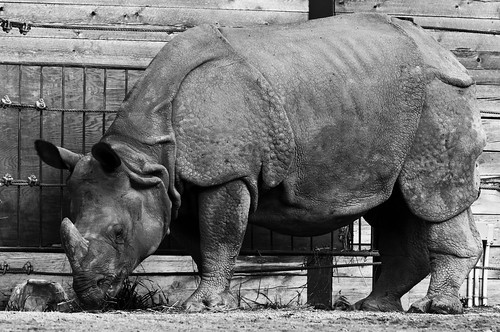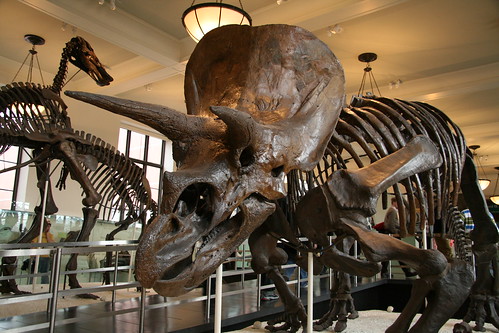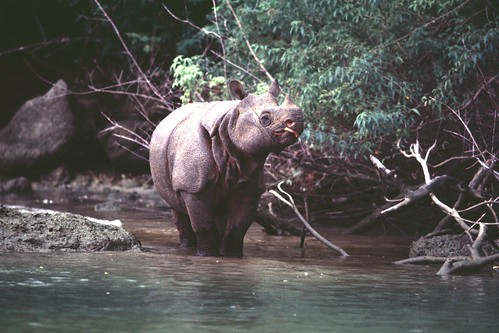
Sumatran rhinoceros (Dicerorhinus sumatrensis);
(Photo by International Rhino Foundation)
This coming Saturday, 22nd September, will be World Rhino Day. It is a day to highlight the ongoing poaching crisis that continues to threaten the survival of all 5 species of rhino, and to push for greater action to put an end to the needless killing over fallacious claims of rhino horn possessing medicinal properties.
While it seems that rhinos were not historically present in Singapore (except as captive specimens), I am particularly fond of rhinos, and have decided to do a series of post in the days leading up to World Rhino Day.
Primer to the Perissodactyla
Where it comes to traditional classifications of hoofed animals, there are 2 main groups: there are the artiodactyls or even-toed ungulates, which typically have hooves with an even number of toes, usually 2 or 4. Cattle, sheep, goats, antelope, deer, giraffes, camels, pigs, hippopotamus are all classified as artiodactyls, and a growing body of fossil and genetic evidence reveals that surprisingly enough, whales too belong to this group, despite their current lack of hooves.










A selection of species representing the 10 families traditionally classified under the Artiodactyla (the additional 14 families of whales, which are now thought to be aquatic artiodactyls closely related to hippos, are not pictured);
Top row (left to right): Camelidae: guanaco (Lama guanicoe); Suidae: (Sus scrofa); Tayassuidae: collared peccary (Pecari tajacu); Hippopotamidae: Hippopotamus (Hippopotamus amphibius);
Middle row (left to right): Tragulidae: Lesser mousedeer (Tragulus kanchil); Giraffidae: Giraffe (Giraffa cameleopardalis); Antilocapridae: Pronghorn (Antilocapra americana); Moschidae: Siberian musk deer (Moschus moschiferus);
Bottom row (left to right): Cervidae: Chital (Axis axis); Bovidae: American bison (Bison bison);
(Photos by viva300, Pigsaw, Meddaugh Photography, @Doug88888, dfg photography, safari-partners, rlw5663, gentle lemur, Radha Rangarajan, and Robert-Bannister)
The other group is the Perissodactyla, or odd-toed ungulates; these have 3 digits on each limb, and in the case of 1 group, only a single toe remains. They were once a highly diverse group, but are now represented by only 3 families, each quite distinct and dissimilar from one another:
There is the Equidae, encompassing the 7 species of horse, ass, and zebra. All surviving equids have only 1 digit on each limb.

Plains zebra (Equus quagga);
(Photo by periss)
The 4 extant species of tapir make up the Tapiridae.

Brazilian tapir (Tapirus terrestris);
(Photo by kaili williams)
And the final surviving family of perissodactyls is the Rhinocerotidae, comprising 5 species of rhinoceros.

White rhinoceros (Ceratotherium simum);
(Photo by Insu Nuzzi)
It is the rhinos that I want to focus on for these next few posts.
Rhinos are NOT prehistoric survivors
But first, it's important to put an end to a statement that I've often seen being used to describe rhinos. There are many who state that rhinos are "prehistoric-looking", although I'm not sure what exactly that means. Perhaps it's their lumbering size and fearsome weaponry, although one then wonders why elephants don't get saddled with such a label. Maybe it's because when compared with other herbivores such as zebra and gazelles, which rely on being fleet of foot to survive, a rhino, which often considers a good offense to be the best form of defence, might seem positively archaic in comparison, a supposed anachronism in an era where we seem to equate speed with sophistication. The wrinkles, bumps, and folds of skin seen on some rhino species, which make them appear as if they are armour-plated, does also possibly contribute to that perception.

Indian rhinoceros (Rhinoceros unicornis);
(Photo by Adam Biesenthal)
Perhaps it's the fact that rhinos are inevitably compared with the ceratopsid or horned dinosaurs of the Late Cretaceous period. Many reconstructions of these large herbivores allude to them being prehistoric equivalents of rhinos, charging at predators and fending them off with their horns. However, biomechanical studies indicate that they probably couldn't gallop like rhinos. Needless to say, these dinosaurs are not related to rhinos at all, except by virtue of being fellow tetrapods.

Triceratops mount, American Museum of Natural History;
(Photo by jbparker)

Sketch of a series of ceratopsian dinosaurs belonging to the subfamily Centrosaurinae, showing (top to bottom) Coronosaurus brinkmani, Centrosaurus apertus, Styracosaurus albertensis and Pachyrhinosaurus canadensis;
(Artwork by Julius Csotonyi)
Others go one step further, and claim that rhinos don't just look prehistoric, they are prehistoric survivors.
There are so many inaccurate statements in this WildAid PSA I don't even know where to begin.
It's understandable why the term "prehistoric" is trotted out so often; here is a group of animals that has weathered much ecological turmoil and upheaval over many millions of years. Ideally, there is nothing to stop rhinos from continuing to thrive and prosper, if not for hunting and human exploitation that have caused them to vanish from large swathes of otherwise suitable habitat. Suggesting that humans could spell the final doom for a family that has survived for so long casts us as key players in the rhinos' fate; we have the power to either cause them to be wiped out once and for all through our greed and belief in bogus cures, or we can stop the slaughter and restore them to their former glory. Similar mentions of great antiquity, claiming that a particular group has survived virtually unchanged for millions of years, are often used to describe other animals like turtles, sharks, and crocodiles.
What I dislike about such a statement is that it's frankly misleading. Yes, the rhinos as a group have been around for a long time, somewhere around 50 million years. But the rhinos we see today are simply not the same as the rhinos that were around 50 million years ago. Just like any other group of organisms, many species of rhino have evolved, lived for a time, and then faded into extinction. Also, there are other groups of animals, like elephants and horses, that have been around for approximately just as long a span of time, so why the unnecessary focus on the rhinos' longevity as a clade? Today's rhino species are not particularly ancient either, with current evidence indicating that they evolved during the Pleistocene, like other large mammals. Tossing in that 50 million year old figure is likely to cause confusion, giving people the false impression that our modern-day rhinos have been around for so long. Similarly, statements about the Sumatran rhinoceros in particular being labelled a "living fossil" prompted Darren Naish to protest and debunk such a notion.
To illustrate this, here's an idea of what rhinos looked like 50 million years ago:

This is Hyrachyus, a fairly small animal thought to represent the early perissodactyls from which rhinos evolved;
(Photo by Carl Wozniak)
Today's rhinos belong to lineages that evolved only around 16 million years ago; for much of their history, rhinos evolved a wide variety of shapes and sizes, and most of the earlier species didn't even have horns. Here are some reconstructions of a selection of prehistoric rhinos:

Hyracodon, Eocene (Approximately 35 million years ago);
(By Charles R. Knight)

Paraceratherium, Oligocene (Approximately 25 million years ago);
(By Chen Yu)

Cadurcodon, Eocene (Approximately 35 million years ago);
(By Roman Yevseyev)

Metamynodon, Eocene (Approximately 35 million years ago);
(By Heinrich Harder)

Chilotherium, Miocene (Approximately 7 million years ago);
(By meribenni)

Elasmotherium, Pleistocene (Approximately 50,000 years ago);
(By Dmitry Bogdanov)
Using the word 'prehistoric' to describe modern-day rhinos can carry a negative connotation, insinuating that these creatures are primitive and increasingly irrelevant and obsolete, relicts from a bygone era. This gives rise to the dangerous notion that perhaps rhinos are ill-adapted to the challenges of the modern world, and doomed to die out, like Sega consoles in the age of PlayStations and Xboxes. Why should we bother investing so much time and resources into cracking down on poaching, and saving the rhinos, if we see them as evolutionary failures anyway? (Extinction is the eventual fate of every species that has ever lived, but that's beside the point)

Javan rhinoceros (Rhinoceros sondaicus);
(Photo by Alain Compost, from International Rhino Foundation)
This probably ties in with the erroneous yet prevalent belief that evolution is solely about progress, changing from a primitive to a more advanced state. To say that a particular lifeform is a prehistoric survivor is to often hint that it has stagnated and failed to keep on improving, a claim that fails to stand up to closer scrutiny when one looks at both fossil and historical records.
After all, rhinos were highly successful animals, and in the course of their long history, came to inhabit much of North America, Eurasia, and Africa. The remains of various extinct rhino species are abundant in many fossil deposits, and judging by the sheer number of bones found at some localities, must have occurred in large herds that dominated the landscape. Our 5 extant species of rhino were themselves once widely distributed across much of Africa and Asia; their much reduced range and numbers today reflect overhunting by humans, not an inability to adapt to the challenges of the modern environment. They have the potential to thrive once again if we allow them to.

Black rhinoceros (Diceros bicornis);
(Photo by thewildlifephotographer)
And don't get me started on statements about "the rhino". There are 5 distinct species of rhinoceros, each with its own distribution, habitat preference, and ecology, and while all are threatened by poaching, to use "the rhino" is the equivalent of talking about the lion, tiger, leopard, jaguar, cheetah, puma, lynxes, and all the other species of felids as "the cat".
Stating that "the rhino" has been around for 50 million years, or that it is a prehistoric survivor, is just plain inaccurate and misleading, and frankly does little to inspire people to protect rhinos and put an end to poaching. Instead of appealing to falsified notions of great antiquity, why not focus on rhinos as symbols of deadly power?
On the other hand, despite their reputation for being solitary, aggressive, and bad-tempered, perhaps it's time that we showed how rhinos can have a playful, endearing side as well. Surely it's about time people dropped that old "prehistoric survivor" drivel, and celebrated rhinos for what they are: majestic, powerful, creatures possessing the weaponry and the willingness to use them to cause much damage, but with a gentle, endearing side as well.
Next up: A closer look at some prehistoric rhinos.